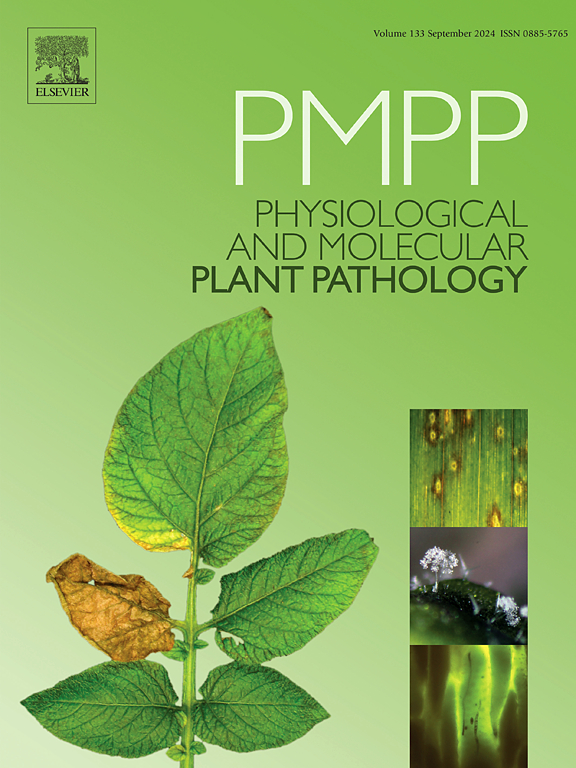Molecular insights into the oil palm (Elaeis guineensis) defense response to Ganoderma boninense infection
IF 2.8
3区 农林科学
Q2 PLANT SCIENCES
引用次数: 0
Abstract
Sustainable oil palm cultivation in the major producing countries, Indonesia and Malaysia is significantly threatened by the fungal pathogen Ganoderma boninense that causes the devastating basal stem rot (BSR). The incidence of the disease has worsened with replanting in previously established plantations resulting in much younger trees being affected. This paper aims to provide a comprehensive review on the response of this important commodity crop to Ganodema boninense at the different stages of infection. It covers the early biotrophic phase when the pathogen established host colonization and the necrotrophic phase when the host succumbed to the disease. It highlights key genes involved in multiple plant defense signaling pathways during oil palm (Elaeis guineensis) infection by Ganoderma boninense, such as nitric oxide associated 1 (EgNOA1), pathogenesis-related protein (EgPR-1), and NADPH oxidase (EgRBOH). It also reviews the roles of transcription factors such as JUNGBRUNNEN 1 (EgJUB1) and Ethylene Responsive Factor 113 (EgERF113) in coordinating defense responses in the biotrophic and necrotrophic phases, respectively, and protein-protein interaction (PPI) involve in regulating oil palm response to the pathogen. Knowledge of molecular interaction of this host plant and the fungal pathogen and the defense mechanisms is essential for developing effective and sustainable strategies for management and treatment of BSR, such as development of an effective disease mitigation strategies and cultivation of disease-resistant oil palm varieties. The review highlights areas which require further research particularly on transcription factors and PPI, to fully elucidate the complex molecular interaction of oil palm and Ganoderma boninense.
油棕(Elaeis guineensis)对牛灵芝(Ganoderma boninense)感染防御反应的分子见解
棕榈油主要生产国印度尼西亚和马来西亚的可持续油棕种植受到真菌病原体灵芝(Ganoderma boninense)的严重威胁,这种真菌病原体会导致毁灭性的基茎腐病(BSR)。由于在以前建立的种植园中重新种植,导致更年轻的树木受到影响,这种疾病的发病率已经恶化。本文旨在全面综述这一重要的商品作物在不同侵染阶段对鲣鱼的反应。它包括病原体建立宿主定植的早期生物营养阶段和宿主屈服于疾病的坏死性营养阶段。它强调了油棕(Elaeis guineensis)被牛灵芝(Ganoderma boninense)感染时参与多种植物防御信号通路的关键基因,如一氧化氮相关1 (EgNOA1)、致病相关蛋白(EgPR-1)和NADPH氧化酶(EgRBOH)。综述了转录因子JUNGBRUNNEN 1 (EgJUB1)和乙烯反应因子113 (EgERF113)在生物营养期和坏死营养期协调防御反应中的作用,以及蛋白-蛋白相互作用(PPI)在调节油棕对病原菌反应中的作用。了解寄主植物与真菌病原体的分子相互作用及其防御机制对于制定有效和可持续的BSR管理和治疗策略至关重要,例如制定有效的疾病缓解策略和培育抗病油棕品种。本文重点介绍了在转录因子和PPI等方面有待进一步研究的领域,以充分阐明油棕与牛灵芝之间复杂的分子相互作用。
本文章由计算机程序翻译,如有差异,请以英文原文为准。
求助全文
约1分钟内获得全文
求助全文
来源期刊
CiteScore
4.30
自引率
7.40%
发文量
130
审稿时长
38 days
期刊介绍:
Physiological and Molecular Plant Pathology provides an International forum for original research papers, reviews, and commentaries on all aspects of the molecular biology, biochemistry, physiology, histology and cytology, genetics and evolution of plant-microbe interactions.
Papers on all kinds of infective pathogen, including viruses, prokaryotes, fungi, and nematodes, as well as mutualistic organisms such as Rhizobium and mycorrhyzal fungi, are acceptable as long as they have a bearing on the interaction between pathogen and plant.

 求助内容:
求助内容: 应助结果提醒方式:
应助结果提醒方式:


